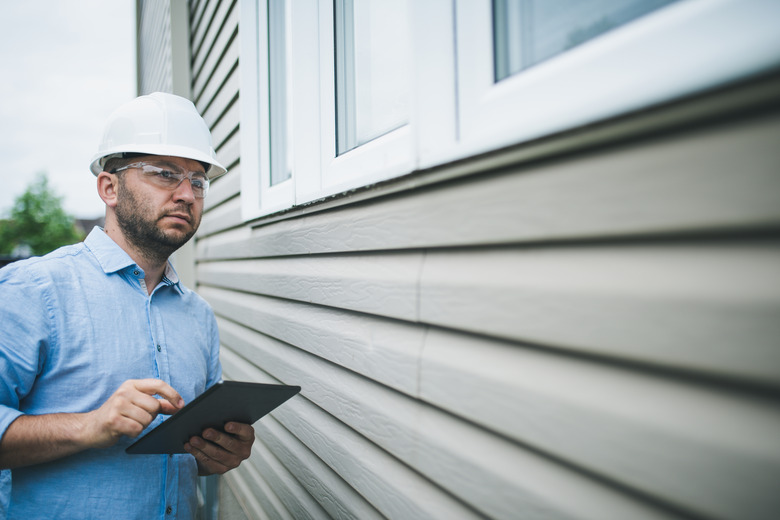Common House Inspection Issues
We may receive a commission on purchases made from links.
Professional home inspectors find problems with any house, no matter its age or how well it's been cared for. All of the issues noted will show up on the inspector's report. Many tend to be minor and fall into the "be aware of" category. Others are major and may be part of the sale negotiations. Because inspectors primarily look for problems that are related to safety as well as high-ticket items, they tend to find more issues in certain areas.
Problems With Roofs
Problems With Roofs
Roofs get a lot of attention because they cost so much to replace and because roof issues let in water that wreaks havoc inside the house (more inspection issues). Apart from normal wear and tear and aging, the most common roof problem is missing or improperly installed flashing. Flashing comes in many forms — metal strips and angles, rubber boots, or a combination of metal and rubber — and it covers joints at all roof transitions and anywhere something pokes through the roof, such as pipes or skylights. Missing or damaged flashing often foretells signs of leaking below.
Foundation-Related Concerns
Most foundations are made of poured concrete or concrete block and, unfortunately, concrete likes to crack. But there are OK cracks and not-OK cracks. Cracks that are reason for concern may be accompanied by evidence of foundation movement or shifting, doors and windows that are out of whack and hard to open, or significant cracks in drywall or plaster walls and ceilings. Foundation walls that bow (usually inward) also can indicate serious issues. In some cases, an inspector may recommend getting an engineer's assessment of the foundation if he sees something suspicious.
Old or Leaky Plumbing
Old or Leaky Plumbing
Just as roof problems are indications of water getting in from outside the house, plumbing leaks are evidence of water damage coming from inside the house. A leaky pipe joint or valve is easy to correct, but even small leaks can create expensive problems for surrounding materials and even a home's structure. Signs of leaks, past or present, are commonly noted on inspection reports.
If the home is old enough to have galvanized steel water pipes, the pipes will be noted on the report, because they'll need to be replaced sooner or later. If there's also low water pressure at some or all of the fixtures in the house, think sooner rather than later. This means the pipes are essentially getting smaller due to corrosion on the inside.
Unsafe or Undersized Electrical
Unsafe or Undersized Electrical
Electricity is by far the most dangerous thing in a house. Accordingly, most electrical problems found during inspections relate to safety. Common minor (inexpensive) issues include improper wiring splices, open or missing junction boxes, damaged wire insulation, loose (unsecured) wiring, and switch or outlet boxes without covers. Old wiring, including knob and tube wiring as well as modern-ish wiring without a ground wire, will be noted on a report but does not necessarily need to be replaced.
A common big-ticket electrical issue is a service panel (breaker box or fuse box) that is too small for the house, hinting that the circuits are likely overloaded. Old panels with fuses almost always should be replaced, not because they are unsafe but because they offer very small service capacity (often about 60 amps, compared to today's standard of 150 or 200 amps). Some modern service panels have been deemed unsafe and are always noted for replacement on inspectors' reports.
Structural Red Flags
Structural Red Flags
In addition to foundation problems, home inspections often find signs of rot or insect damage in wood structures. Undersized joists (horizontal floor supports) and beams are revealed by sagging or other signs of stress. Joists with oversize holes or notches (usually cut by lazy plumbers or unwitting DIYers) also are commonly noted on inspection reports.
Other structural red flags are window and door openings that are no longer square or have significant cracking in the surrounding wall surfaces, roof rafters that sag or are too small for their spans, and archways or large doorway openings between rooms that droop overhead (indicating an undersized support beam). Home inspectors also take a close look at outdoor decks, finding improper footings (foundations), rotted wood, and structural and rot issues where the deck anchors to the house.
Issues With the Exterior
Issues With the Exterior
Many inspection items catch the inspector's eye on the initial approach to the house: cracked driveways and walkways, sloping stoops and patios, peeling paint, damaged siding and trim, leaning fences and gates, cracked windows, torn screens, droopy gutters and missing downspouts. Inspectors also never fail to check the ground around the house. It should slope down so that water runs away from the house's foundation, not toward the house (and likely the basement).
